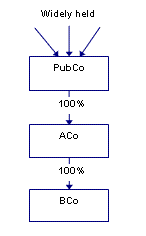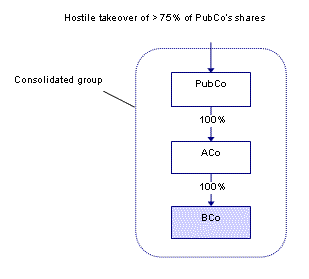Taxation Determination
TD 2004/88
Income tax: consolidation: does the continuing majority-owned entity test in subsections 701A-1(1) and 701A-1(2) of the Income Tax (Transitional Provisions) Act 1997 require tracing through interposed entities to the ultimate beneficial owners to determine whether there has been a change in the majority ownership of an entity during the period from 27 June 2002 until the entity becomes a subsidiary member of a consolidated group?
-
Please note that the PDF version is the authorised version of this ruling.
FOI status:
may be releasedPreamble
| The number, subject heading, date of effect and paragraphs 1 to 3 of this document are a 'public ruling' for the purposes of Part IVAAA of the Taxation Administration Act 1953 and are legally binding on the Commissioner. |
1. Yes. In determining whether there has been a change in the majority ownership of an entity, for the purpose of applying the continuing majority-owned entity test in section 701A-1 of the Income Tax (Transitional Provisions) Act 1997 ('IT(TP)A 1997'), it is necessary to trace through all interposed entities to the ultimate beneficial owners of the entity.
2. Pursuant to subsection 701A-1(1) of the IT(TP)A 1997, an entity that is a subsidiary member of a consolidated group is a 'continuing majority-owned entity' if a person or persons continue to be 'majority owners' of the entity from the start of 27 June 2002 until the entity became a subsidiary member of the group (the test period ). This period brings into account the ownership structure immediately after the time that the entity became a subsidiary member.
3. Pursuant to subsection 701A-1(2) of the IT(TP)A 1997, a person or persons are 'majority owners' if they beneficially own, directly or indirectly through one or more interposed entities, membership interests in the entity whose market value is more than 50% of the market value of all membership interests in the entity.
4. The integrity measures contained in sections 701A-5 of the IT(TP)A 1997 about trading stock and 701A-10 of the IT(TP)A 1997 about internally generated assets apply in relation to the entity if there is any person, or there are any persons, who continued to be majority owners throughout the test period. This will be the case if there has been no change in the ultimate beneficial ownership of the entity.
5. An entity unable to provide evidence of this change will be required to treat trading stock and internally generated assets in accordance with these integrity measures.
Example
Majority beneficial ownership test (widely held ownership of head company)
Facts
6. As at 26 June 2002, PubCo, a publicly listed corporation on the Australian Stock Exchange, owns 100% of the shares in ACo, an Australian-resident company. On that date BCo, an Australian-resident company, is a wholly-owned subsidiary of ACo, and holds trading stock and internally generated assets.
Figure 1: PubCo group at 26.6.2002

7. On 31 December 2002, a hostile takeover of more than 75% of PubCo's listed shares takes place, resulting in a change in majority ownership of PubCo.
8. On 1 July 2003, PubCo forms a consolidated group comprising itself as head company with subsidiary members ACo and BCo.
9. There are no changes to PubCo's membership interests in ACo and ACo's membership interests in BCo from 26 June 2002 until the consolidation time of 1 July 2003.
Figure 2: PubCo group on consolidation

Applying the test
10. On 31 December 2002, a hostile takeover of PubCo resulted in a change in ownership of PubCo at the ultimate beneficial ownership level. Although there has been no change in PubCo's ownership of ACo or BCo, the test for majority ownership in section 701A-1 of the IT(TP)A 1997 requires a 'bottom-up' tracing approach (through widely held or public companies, including publicly listed companies) to the ultimate beneficial owners to determine whether or not the integrity measures apply.
11. Given the change in majority beneficial ownership which has taken place at the ultimate beneficial ownership level, PubCo, ACo and BCo do not qualify as continuing majority-owned entities. As a result, the integrity measures do not apply to BCo's trading stock and internally generated assets for the purpose of cost setting.
Date of Effect
12. This Determination applies to years commencing both before and after its date of issue. However, it does not apply to taxpayers to the extent that it conflicts with the terms of settlement of a dispute agreed to before the date of the Determination (see paragraphs 21 and 22 of Taxation Ruling TR 92/20).
Commissioner of Taxation
22 December 2004
Previously issued as Draft TD 2004/D64
References
ATO references:
NO 2004/10517
Related Rulings/Determinations:
TR 92/20
Subject References:
Consolidation
Legislative References:
TAA 1953 Pt IVAAA
ITAA 1997 Div 705
IT(TP)A 1997 701A-1
IT(TP)A 1997 701A-1(1)
IT(TP)A 1997 701A-1(2)
IT(TP)A 1997 701A-5
IT(TP)A 1997 701A-10
